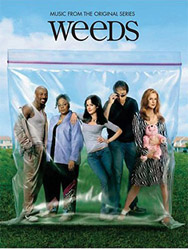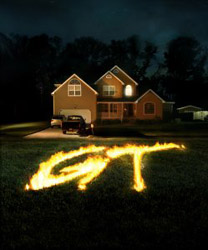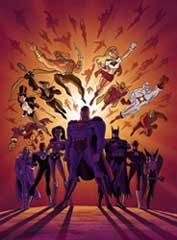Shiny Things
By BOP Staff
July 9, 2008
 Weeds
Weeds
Showtime's highest rated series did the unthinkable when the new season premiered in mid-June. The entire show, along with its principle cast members, permanently moved from the fictional Los Angeles suburb of Agrestic – the show's official home for the first three seasons – to Ren Mar, California. Talk about risky. I don't even know for certain whether this is the first time a change of this magnitude has happened on televison before. But either way, I must say I stamp my seal of approval on this (potentially) unprecedented update.
And the showrunners didn't just do it for kicks. What season three evolved into practically beckoned the change. First of all, the neighborhood went up in flames at the end of the season anyway, so Nancy Botwin (Mary-Louise Parker) and company didn't really have anywhere to go but out. Second, the move matches the comedy's recurring theme of "Nancy on the run." Though Nancy doesn't exactly fit the stereotypes of the typical pot dealer – she's female, lives in the suburbs, and is white – the feds were slowly catching on to her act, and may have finally nailed her for good if she didn't get out of there, and fast. Finally, the shift to Ren Mar opens Nancy up to a whole different kind of drug trade, specifically drug trafficking across the border to Mexico, which is something the single mom has yet to dig her hands into.
And helping to familiarize the Botwin family with their new surroundings is none other than Albert Brooks, who here plays Nancy's snappy father-in-law, Lenny Botwin, in a multi-episode story arc. He certainly isn't a fan of Nancy either, due in part to Lenny's preference to his late son's girlfriend before Nancy ever showed up. This disparity led to some funny (albeit awkward) scenes in earlier episodes of the new season.
My only real qualm with the refurbished Weeds is the lack of face time with characters outside the Botwin family, like Celia Hodes (Elizabeth Perkins) and Doug Wilson (Kevin Nealon). Sure, the show occasionally checks in on their happenings back in Agrestic, but they aren't on the show nearly as much as they used to be. However, word is Doug will seek soon seek refuge with Nancy in Ren Mar, and who knows, maybe Celia will follow suit.
So kudos to Jenji Kohan and the rest of the team behind Weeds. The changes were definitely risky, especially for a show already doing quite well in the ratings game – at least for Showtime. I mean, if it ain't broke, don't fix it, right? But (so far, anyway) the payoff has been overwhelmingly positive. (Eric Hughes/BOP)
|
|
|
 The Fall
The Fall
Sometimes it's easy to forget that film is first and foremost a visual art form. There are only a handful of directors working today who take full advantage of the canvas of cinema to tell their stories. Alfonso Cuaron, the Coens, and Tim Burton are a few who come to mind. After The Fall, flat-out one of the most visually amazing films I've ever seen, I would add Tarsem Singh to that list.
With a structure similar to The Princess Bride, The Fall is two stories in one - the first concerns a young girl (Catinca Untaru) in a hospital who befriends an injured stuntman (Lee Pace), and the second is the epic tale he tells her. After a stunning black and white opening credit sequence that gives me chills just thinking about it, the film settles into its pattern of switching between the stories, which eventually begin to melt together. Like Atonement, The Fall is a story about storytelling. We see the epic tale part through the little girl's eyes only, which colors it in ways the teller might not have intended. Gradually, we realize that the stuntman may have ulterior motives for telling his story, and this adds a layer of suspense to the hospital scenes. Pace, from TV's Pushing Daisies and particularly newcomer Untaru give incredible performances, and their chemistry together drives both halves of the story in ways that don't become clear until the end.
The Fall was shot on locations all over the world, and was made without computer effects, setting it apart from, say, Jumper, which appears to have been shot on locations all over the studio. The Fall will show you sights never seen before on film - a chandelier made of human bodies, an elephant swimming off a tiny island, a man emerging from inside a burning bush in the desert - and you'll be grateful that Tarsem actually made the trek to these places, and didn't half-ass it with some dodgy CGI. This is a film that absolutely must be seen on the biggest screen possible. It's an epic of the old-fashioned variety, with enormous scope and ambition; please, for the love of God, don't watch it on your iPod. (Shane Jenkins/BOP)
|
|
|
 Girl Talk - Feed the Animals
Girl Talk - Feed the Animals
Here's the trouble with Girl Talk: he's impossible to describe. Yet, music journalists absolutely love trying. And here I am, joining those verbose ranks.
To call Girl Talk a DJ or a Mash-Up artist is unfair. If a Mash-Up artist is a kid with a stick and a DJ is a little leaguer, then Girl Talk is Ichiro. The best phrase I've heard used to describe Girl Talk's bizarre, immensely infectious albums is "reconstructivist art" – the process of taking a bunch of other pieces of art apart and shaping them back together into something new.
One 'track' of a Girl Talk album will contain 15 to 20 constituent parts of other songs – some platinum hits, some tiny indie tracks or mere beats – compiled into something that you can neither define nor turn away from.
Girl Talk (born Gregg Gillis) gained a huge following after his previous album, "Night Ripper," that led to worldwide club gigs, high-profile sets at just about every American music festival you can name, and coverage in every music mag and blog of note – all while Gillis maintained a calm, daylight alter-ego as a shirt-and-tie employee in a drab Pittsburgh office building. With the success of "Night Ripper," though, Gillis was finally able to drop the day job and work on music full time; the first product of that dedication is his fourth full-length album, "Feed the Animals."
What comes out? Many, many things. The chigga-chigga-chigga bit of Metallica's "One" rages beneath Lil' Mama, making "My Lip Gloss is Poppin'" sound like a declaration of war. Rick Springfield and (Oscar winners) Three Six Mafia compare the respective virtues of Jessie's Girl and oral sex, while The Prodigy helps out with the rhythm. And on the third track, "Still Here"...well, it's hard to describe, but within sixty seconds, Radiohead, The Band, Ben Folds Five, Ace of Base, Cassidy, and Fergie are involved. I think "Footloose" is in there for a second, too.
The album is being released name-your-price style through his label website (the quick link is http://74.124.198.47/illegal-art.net/ ;) a series of incentives are available to urge you to actually pay something, but you can choose to get it for free. Download "Feed the Animals," and be prepared to listen to nothing else for about two weeks – and explain to your friends why you're listening to "In a Big Country" and "Whoomp! There it Is" at the same time. (Sean Collier/BOP)
|
|
|
 Justice League Unlimited
Justice League Unlimited
I think in this superhero summer we are living in, it's easy to forget, overlook or plain ignore some truly awesome superhero based entertainment simply because it's animated. Justice League started as a simple cartoon in 2001 and was pretty good initially, but after season 2, the producers and writers literally took off the gloves and got dirty with the series. The group got permission from DC to access nearly the entire DC continuity and characters and they went crazy.
Let me put this right into perspective. The first two seasons of Justice League area nice steak. Seasons 3, 4 and 5 are the cartoon equivalent of Kobe Beef. They are amazing. Seasons 3 and 4 are dedicated to a fight with Cadmus, a government agency whose directive it is to develop super powered agents that work for and can defend the government. Cadmus is being backed by and works loosely with Lex Luthor (voiced by the always intimidating Clancy Brown) and produces some truly epic episodes in this storyline.
The animation isn't exactly top notch in this show, but it doesn't have to be as the writing more than compensates for any lack of cutting edge cartooning. The show was obviously produced on a budget, and while that shows, it did have the effect of making things much tighter. The voice acting is also done with a lot of panache and you'll scratch your heads trying to place some truly familiar voices. In addition to Brown, Mark Hamill, Dana Delaney, Robert Picardo, Michael Dorn, Powers Boothe, Dave Thomas, James Remar, Oded Fehr, Gina Torres and Ron Perlman all contribute their voices to the effort from episode to episode.
But the true strength of this series are the episodes themselves. There are some absolutely phenomenal ones in here. Clash! from Season 4 features an all out brawl between Captain Marvel and Superman. To say the town they are fighting in suffers is an understatement. Initiation from Season 3 features Green Arrow, Supergirl, Captain Atom and Green Lantern against a giant Chinese nuclear robot and it's the equal of any superhero major motion picture. Destroyer from Season 5 features a throwdown between Superman and Darkseid, and the producers did not pull any punches with that one, either. At one point during the episode, Superman comments calmly, "What we have here is a rare opportunity for me to cut loose." And he does not disappoint. Very few of the episodes do, but these are some of the really good ones.
The series ended in 2006 when DC pulled the plug on the series due to ‘licensing issues'. It was never made clear what the exact licensing issues were, but with Superman returns poised to arrive at the box office and Batman Begins already having made a mark, it's pretty clear what continuity DC wanted to focus on, and it wasn't the animated one. And that's truly a shame, because a lot of effort went into this show on every angle. There was continuity, character development, amazing storylines and plenty of action.
The disks have recently dropped in price from major retailers and that seems odd, as this really is a stellar series. If you're looking for some truly excellent superhero based entertainment, (perhaps to wash the taste of Hancock out of your mouth...) I heartily recommend this series. It really is a shame that it's gone. (Scott Lumley/BOP)
|
|
|
 Flipping Out
Flipping Out
Reality programming on television is usually anything but real. The majority of shows are at least partially scripted, contestants typically endure a rigorous audition process before coming on board and editors wield the awesome ability to (with a couple strategic cuts) turn any character into a villan or a hero at any given moment. It's the plastic surgery model for television - all pretty and naturalistic on the outside, but requiring a host of talented technicians to maintain the facade.
This is one of the reasons why I have fallen in love with Flipping Out on Bravo. The series follows real estate speculator, Jeff Lewis, as he "flips" houses - purchasing, stripping them down, rebuilding, refurnishing, redecorating and selling them for profit. The catch here is that Jeff struggles daily with OCD, to the detriment and constant consternation for his business associates and staff.
Considering the enormous investments required for each house he flips and the volatile housing market in California, it's no surprise that Jeff's already tense personality will quickly flare up into arguments, vitriolic lectures, scream sessions and full on temper tantrums. As his stress level rises, working for Jeff becomes more and more like walking a tightrope with a long stick that has a bucket full of bricks on one end and a bucket full of boiling water on the other - one wrong step and you'll either come out bruised or burned.
Now here's why Flipping Out works as compelling reality television: it balances unscripted drama with narcisstic observations. With regard to the first point, the drama in Jeff's life is real. He has millions of dollars invested in six to seven properties at any given moment and if he can't find an affordable designer, a reliable crew and a serious buyer, his life and business could quickly become one big financial quagmire. This possibility hangs over every episode in palpable fashion.
Secondly, Jeff's OCD makes him quite the demanding boss. Taken individually, his requests are rationale and understandable . . . and Jeff takes ample time to (in an almost condescending fashion) make sure we recognize the validity of his requests. For instance, when he asks his house assistant for a "Grande nonfat, no-foam, 140-degree, two-Splenda latte" and then amends the order to "Make it 150-degrees so that I can drink it by the time you're back," it makes perfect sense. Who likes cold coffee? But taken cumulatively, the requests form a veritable bombardment of irrationality due to the respite-free, rapid-fire manner in which they arrive. Make sure there are no onions on his salad, combine all of his breathmints into the same dispenser, paint the curb red so that no one can park here, fire my current psychic, find me a new psychic . . . the patience of his crew seem inhuman at times. And yet, in his narration and monologues, Jeff has the opportunity to clarify and expound upon every move that he makes. It's reminiscent of the best parts of the early seasons of The Real World on MTV.
The combination of these two elements make for one great hour of TV on Bravo. At the very least, it'll make you wish that you had enough money to buy one of Jeff's houses. (Jason Lee/BOP)
|
|
|
|
|
|
|

